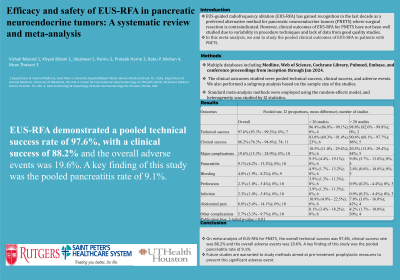Monday Poster Session
Category: Interventional Endoscopy
P2745 - Efficacy and Safety of EUS-RFA in Pancreatic Neuroendocrine Tumors: A Systematic Review and Meta-Analysis
Monday, October 28, 2024
10:30 AM - 4:00 PM ET
Location: Exhibit Hall E

Has Audio

Vishali Moond, MD
Saint Peter's University Hospital
New Brunswick, NJ
Presenting Author(s)
Vishali Moond, MD1, Khyati Bidani, MD1, Jiteshwar S. Pannu, MD2, Prateek Harne, MD3, Sruthi Subramanian, MD3, Babu Mohan, MD4, Nirav Thosani, MD3
1Saint Peter's University Hospital, New Brunswick, NJ; 2University of Oklahoma Health Sciences Center, Oklahoma City, OK; 3McGovern Medical School at UTHealth, Houston, TX; 4Orlando Gastroenterology PA, Orlando, FL
Introduction: EUS-guided radiofrequency ablation (EUS-RFA) has gained recognition in the last decade as a preferred alternative method for pancreatic neuroendocrine tumors (PNETS) where surgical resection is contraindicated. However, clinical outcomes of EUS-RFA for PNETS have not been well studied due to variability in procedure techniques and lack of data from good quality studies.In this meta-analysis, we aim to study the pooled clinical outcomes of EUS-RFA in patients with PNETS.
Methods: We conducted a search of multiple electronic databases and conference proceedings from inception through Jan 2024. The clinical outcomes studied were pooled technical success, clinical success and adverse events. We also performed a subgroup analysis based on the sample size of the studies. Standard meta-analysis methods were employed using the random-effects model, and heterogeneity was studied by I2 statistics.
Results: We analyzed 11 studies which included 7 prospective and 4 retrospective studies involving 345 patients (55.3% females with a mean age of 58.73 +/- 3.01 years) having mean tumor size of 13.87 +/- 0.82 cm and a mean duration follow-up of 13.36 months.
The pooled technical success rate of EUS-RFA for PNETS was 97.6% (CI 93.3 - 99.2%; I2 = 0%) and the pooled clinical success rate was 88.2% (76.3 - 94.6%; I2 = 74%). The pooled overall adverse event rate associated with EUS-RFA for PNETS was 19.6% (15.3 - 24.9%; I2 = 0%). The pooled rates of pancreatitis, bleeding, perforation, infection, and abdominal pain associated per procedure were as follows: 9.1% (6.2 - 13.2%; I2 = 0%); 4.0% (1.9 - 8.2%; I2 = 0%); 2.3% (1.0 - 5.4%; I2 = 0%); 2.3% (1.0 - 5.4%; I2 = 0%) and 8.8% (5.4 - 14.1%; I2 = 0%), respectively. There were no reported deaths with EUS-RFA.
Due to the presence of small sample-size studies, subgroup analysis based on patient sample size of number (N) >20 and (N) < 20 was performed. The pooled clinical success rate for studies with N >20 was 90.6% (68.1 - 97.7%), whereas with N< 20 was 83.0% (69.3 - 91.4%).
Discussion: On meta-analysis of EUS-RFA for PNETS, the overall technical success was 97.6%, clinical success rate was 88.2% and the overall adverse events was 19.6%. A key finding of this study was the pooled pancreatitis rate of 9.1%. Future studies are warranted to study methods aimed at pre-treatment prophylactic measures to prevent this significant adverse event.
Note: The table for this abstract can be viewed in the ePoster Gallery section of the ACG 2024 ePoster Site or in The American Journal of Gastroenterology's abstract supplement issue, both of which will be available starting October 27, 2024.
Disclosures:
Vishali Moond, MD1, Khyati Bidani, MD1, Jiteshwar S. Pannu, MD2, Prateek Harne, MD3, Sruthi Subramanian, MD3, Babu Mohan, MD4, Nirav Thosani, MD3. P2745 - Efficacy and Safety of EUS-RFA in Pancreatic Neuroendocrine Tumors: A Systematic Review and Meta-Analysis, ACG 2024 Annual Scientific Meeting Abstracts. Philadelphia, PA: American College of Gastroenterology.
1Saint Peter's University Hospital, New Brunswick, NJ; 2University of Oklahoma Health Sciences Center, Oklahoma City, OK; 3McGovern Medical School at UTHealth, Houston, TX; 4Orlando Gastroenterology PA, Orlando, FL
Introduction: EUS-guided radiofrequency ablation (EUS-RFA) has gained recognition in the last decade as a preferred alternative method for pancreatic neuroendocrine tumors (PNETS) where surgical resection is contraindicated. However, clinical outcomes of EUS-RFA for PNETS have not been well studied due to variability in procedure techniques and lack of data from good quality studies.In this meta-analysis, we aim to study the pooled clinical outcomes of EUS-RFA in patients with PNETS.
Methods: We conducted a search of multiple electronic databases and conference proceedings from inception through Jan 2024. The clinical outcomes studied were pooled technical success, clinical success and adverse events. We also performed a subgroup analysis based on the sample size of the studies. Standard meta-analysis methods were employed using the random-effects model, and heterogeneity was studied by I2 statistics.
Results: We analyzed 11 studies which included 7 prospective and 4 retrospective studies involving 345 patients (55.3% females with a mean age of 58.73 +/- 3.01 years) having mean tumor size of 13.87 +/- 0.82 cm and a mean duration follow-up of 13.36 months.
The pooled technical success rate of EUS-RFA for PNETS was 97.6% (CI 93.3 - 99.2%; I2 = 0%) and the pooled clinical success rate was 88.2% (76.3 - 94.6%; I2 = 74%). The pooled overall adverse event rate associated with EUS-RFA for PNETS was 19.6% (15.3 - 24.9%; I2 = 0%). The pooled rates of pancreatitis, bleeding, perforation, infection, and abdominal pain associated per procedure were as follows: 9.1% (6.2 - 13.2%; I2 = 0%); 4.0% (1.9 - 8.2%; I2 = 0%); 2.3% (1.0 - 5.4%; I2 = 0%); 2.3% (1.0 - 5.4%; I2 = 0%) and 8.8% (5.4 - 14.1%; I2 = 0%), respectively. There were no reported deaths with EUS-RFA.
Due to the presence of small sample-size studies, subgroup analysis based on patient sample size of number (N) >20 and (N) < 20 was performed. The pooled clinical success rate for studies with N >20 was 90.6% (68.1 - 97.7%), whereas with N< 20 was 83.0% (69.3 - 91.4%).
Discussion: On meta-analysis of EUS-RFA for PNETS, the overall technical success was 97.6%, clinical success rate was 88.2% and the overall adverse events was 19.6%. A key finding of this study was the pooled pancreatitis rate of 9.1%. Future studies are warranted to study methods aimed at pre-treatment prophylactic measures to prevent this significant adverse event.
Note: The table for this abstract can be viewed in the ePoster Gallery section of the ACG 2024 ePoster Site or in The American Journal of Gastroenterology's abstract supplement issue, both of which will be available starting October 27, 2024.
Disclosures:
Vishali Moond indicated no relevant financial relationships.
Khyati Bidani indicated no relevant financial relationships.
Jiteshwar Pannu indicated no relevant financial relationships.
Prateek Harne indicated no relevant financial relationships.
Sruthi Subramanian indicated no relevant financial relationships.
Babu Mohan indicated no relevant financial relationships.
Nirav Thosani indicated no relevant financial relationships.
Vishali Moond, MD1, Khyati Bidani, MD1, Jiteshwar S. Pannu, MD2, Prateek Harne, MD3, Sruthi Subramanian, MD3, Babu Mohan, MD4, Nirav Thosani, MD3. P2745 - Efficacy and Safety of EUS-RFA in Pancreatic Neuroendocrine Tumors: A Systematic Review and Meta-Analysis, ACG 2024 Annual Scientific Meeting Abstracts. Philadelphia, PA: American College of Gastroenterology.
